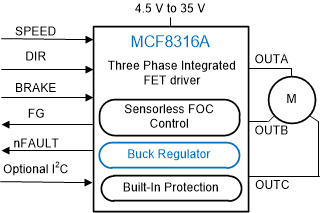SLLU335A August 2021 – January 2022 MCF8316A
- 1Revision History
- 2Introduction
- 3Essential Controls
-
4Basic Controls
- 4.1 Device and Pin Configuration
- 4.2 System Level Configuration
- 4.3
Control Configurations
- 4.3.1 Motor Parameter Estimation to Minimize Motor Parameter Variation Effects
- 4.3.2 Initial Speed Detection of the Motor for Reliable Motor Resynchronization
- 4.3.3 Unidirectional Motor Drive Detecting Backward Spin
- 4.3.4 Preventing Back Spin of Rotor During Startup
- 4.3.5 Faster Startup Timing
- 4.3.6 Gradual and Smooth Start up Motion
- 4.3.7 Improving Speed Regulation
- 4.3.8 Stopping Motor Quickly
- 4.3.9 Preventing Supply Voltage Overshoot During Motor Stop.
- 4.3.10 Protecting Against Rotor Lock or Stall Condition
- 4.3.11 Maximizing Thermal Efficiency and Increasing Thermal Performance
- 4.3.12 Mitigating Electromagnetic Interference (EMI)
- 4.3.13 Faster deceleration
2 Introduction
The MCF8316A provides three half-H-bridge integrated MOSFET drivers with sensorless FOC control to drive a three-phase brushless DC (BLDC) motor at 12-V/24-V DC rails or battery powered applications. The device integrates three current-sense amplifiers (CSA) with integrated current sense for sensing the three phase currents of BLDC motors to achieve optimum FOC control. Simplified schematic of MCF8316A is shown in Figure 2-1.
 Figure 2-1 Simplified Schematic of MCF8316A.
Figure 2-1 Simplified Schematic of MCF8316A. This tuning guide provides the steps to tune a 3-phase BLDC motor using the MCF8316A. The tuning process is classified into two sections: Essential controls and Basic controls. This process is also detailed in the Guided tuning section in the GUI.
Essential controls: Tuning steps to successfully spin the motor in closed loop.
Basic controls: Tuning steps to conform to use-case and explore features in the device.